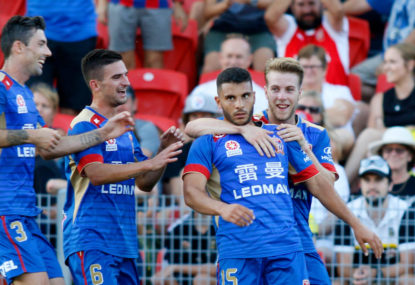By halftime in last night’s A-League clash in Coffs Harbour, Melbourne City had completed 241 passes. Newcastle had completed 95.
Luke Brattan had wafted a free kick about 25 metres too long, over the heads of all of his teammates. Nigel Boogaard had squarely blocked a Josh Rose rocket-shot with the bridge of his nose.
Where Melbourne City had enjoyed the ball, like a spoilt child rolling a sweetie around in their mouth, happily clutching a huge bag of the morsels, Newcastle had feverishly feasted on their own sweet moments of possession, desperate to make the most of them.
Desperate is the word, because both teams had reason to be just that; Newcastle, beneficiaries of the wide belt of mediocrity looped around the pudgy middle of this season’s A-League, would leapfrog two teams into the top six by winning.
City, with the Melbourne Derby coming up – and now with only the prospect of a second-place finish as a realistic goal – had to take advantage of the Victory’s loss to Sydney in the Big Blue.
Yes, these reasons were not equally weighted, but they were enough to make us believe we might see a hotly contested match, played on a super pitch, in lovely Coffs.
City though, were sluggish. When a team sets up in the manner the Jets did – the most obvious approach for any less-talented team that has to play City – their superior opponents must match the grit and gristle with an added layer of attacking zest to apply more than the usual pressure.
Big banana skin puns aside, this was always going to be a tough game for City, away from home, with complicated travel arrangements, against a team who would defend stoutly, and who have potent counter-attacking weapons.
When Andrew Nabbout beat the offside trap, and raced through one-on-one with Dean Bouzanis, it was simply a moment that confirmed which team had decided to embrace the lactic acid, to meet the long odds with relish, and buck them.
He slotted home the first goal, and Newcastle’s play following it held multiple textbook examples of how to counter-punch against a team that has been lulled into committing players forward.
Andrew Hoole conducted swift, well-oiled lateral sequences all evening, often launching from an unnaturally deep position, using his rare pace and ability to manoeuvre in congested areas. Ma Leilei, often a little ponderous in possession, but also a fine, subtle passer, was also involved.
City are notorious for scattering horribly when under sudden pressure, backtracking against a rapid break – the goals they conceded against Perth in that 3-3 draw are great examples.
Here it was the same; when Melbourne had the ball, the pitch seemed a few metres narrower, with Jets whizzing in and out looking to spoil. But when the City possession was hacked away, suddenly Newcastle had handsome room to breathe, with clear angles to pass along, making breezy progress up the pitch as City defenders backed-off when they should have stepped up, or vice-versa.
That Melbourne had a poor first half, and Newcastle a good one, was in polar contrast to their tendencies this season. At the break, with just a goal between them, a reverse of their second-half tendencies could easily have come next. And though City started with the usual post-break brightness, it was another vibrant counter-attack, again beautifully finished by Nabbout, that gave Newcastle a deserved cushion.
At that point, their energy and endeavour had paid dividends, and with a two-goal lead, Newcastle could simply defend against City’s impotent possession. A penalty won by Ivan Franjic dragged the away side back into the game, but had Leilei, or Hoole, taken their clear chances to add a third goal, the win would have been seen out much more comfortably.
There is an issue with incision for City. They ended up making more than double Newcastle’s passes, and although the stat sheet will show an acceptable number of passes into the opposition box, looking at City’s passing map shows how most of their incursions into the penalty area occurred in the least threatening parts. For a huge portion of the second half, when the Jets were raggedly holding on, there was some extended fiddling down the City right, with Bruce Kamau and others dillying and dallying on the edge of the area, without much tangible product at the end.
It is a problem that a team that enjoyed as much possession as City did, right outside the top of the Jets’ box, passed so infrequently into it.
Tim Cahill played in this match, not that you would have noticed. City had last season’s top scorer on the park, as well as Australia’s greatest goalscorer, and neither were utilised. The Jets’ defensive system neutralised them, but so little was done in response by City to impose their own quality.
“We’re going to face [deep defences],” Michael Valkanis said after the game. “Especially away from home, that’s going to happen. It’s part of the game we’re going to have to keep working on, and hopefully start capitalising on the chances we create.”
Valkanis was also asked about his defence, and the problems they tend to encounter against counter-attacking teams. His response was that his team should have nullified the danger further up the park, which is true, but the defence is also to blame.
City’s caretaker coach has persisted with his back four, leaving Ruon Tongyik on the bench again. There has been no difference, in terms of competence under counter-pressure, to the fluid back three that John van’t Schip used.
Osama Malik doesn’t seem markedly more stable than Tongyik, and it was him that was so meekly beaten by Hoole’s simple touch, allowing for Nabbout’s second goal.
So it was Newcastle, now deserved members of the top six, who walked away smiling. City continue to sleepwalk into defeats, and with the Victory next, are yet to be roused from their haze.





























































































